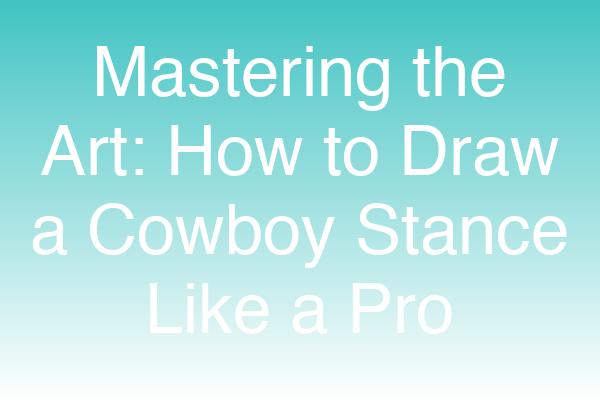
Categories: Drawing Techniques, Art Tutorials, Character Design
Tags: how to draw a cowboy stance, cowboy drawing, character stance, drawing tutorials, art techniques, western art, figure drawing
Introduction
Are you ready to saddle up and learn how to draw a cowboy stance? Whether you're an aspiring artist or a seasoned pro, capturing the essence of a cowboy in action can be a thrilling challenge. This guide will walk you through the steps to create a dynamic and authentic cowboy stance, perfect for illustrations, comics, or character design. By the end of this post, you'll have the skills to depict a cowboy ready for adventure, complete with the right posture and attitude.
Understanding the Cowboy Stance
Before we dive into the drawing process, it’s essential to understand what makes a cowboy stance unique. A cowboy stance typically embodies confidence, readiness, and a touch of rugged charm. Here are some key characteristics:
- Posture: A slight lean forward, suggesting action or readiness.
- Leg Position: Feet shoulder-width apart, often with one foot slightly forward.
- Arm Placement: Hands on hips or resting on a holster, conveying authority.
- Facial Expression: A determined or relaxed look, depending on the context.
Key Elements of a Cowboy Stance
| Element | Description |
|---|---|
| Feet | Shoulder-width apart, one foot forward |
| Legs | Slight bend at the knees |
| Arms | Hands on hips or holster |
| Torso | Slight lean forward |
| Head | Tilted slightly, looking ahead or to the side |
Step-by-Step Guide to Drawing a Cowboy Stance
Step 1: Basic Shapes
Start by sketching the basic shapes that will form the foundation of your cowboy. Use simple geometric shapes to outline the head, torso, arms, and legs.
- Head: Draw an oval for the head.
- Torso: Use a rectangle for the upper body.
- Arms and Legs: Use cylinders to represent the arms and legs.
Step 2: Define the Pose
Next, refine the shapes to define the cowboy's pose. Focus on the following:
- Legs: Position one leg slightly forward and bend the knees slightly.
- Arms: Position the arms on the hips or in a relaxed pose.
- Torso: Lean the torso slightly forward to suggest action.
Step 3: Add Details
Now, it’s time to add details that bring your cowboy to life:
- Clothing: Sketch in the cowboy hat, boots, and any accessories like a bandana or belt.
- Facial Features: Add eyes, nose, and mouth to express the cowboy's personality.
- Texture: Use lines to indicate clothing folds and textures.
Step 4: Finalize the Drawing
Once you’re satisfied with the details, go over your lines with a darker pencil or ink. Erase any unnecessary sketch lines and add shading to create depth.
Step 5: Color Your Cowboy
If you choose to add color, think about the palette you want to use. Traditional cowboy colors include browns, tans, and blues, but feel free to get creative!
Expert Tips for Drawing a Cowboy Stance
- Study Reference Images: Look at photographs or illustrations of cowboys to understand their posture and clothing.
- Practice Gesture Drawing: Quick sketches of different poses can help you capture the essence of movement.
- Use Dynamic Angles: Experiment with different perspectives to make your drawing more engaging.
"Drawing is not just about what you see; it's about what you feel. Capture the spirit of the cowboy in every stroke." - Jane Doe, Professional Illustrator
Common Mistakes to Avoid
- Stiff Postures: Cowboys are dynamic figures; ensure your stance reflects movement.
- Ignoring Proportions: Keep an eye on the proportions of the body to maintain realism.
- Overcomplicating Details: Start simple and gradually add complexity to avoid overwhelming your drawing.
Visual Content Suggestions
- Infographic: Create an infographic summarizing the steps to draw a cowboy stance.
- Video Tutorial: A short video demonstrating the drawing process can enhance understanding.
- Before and After Images: Show the progression from basic shapes to the finished cowboy stance.
Conclusion
Now that you know how to draw a cowboy stance, it’s time to put your skills to the test! Remember, practice makes perfect, so don’t hesitate to try different poses and styles. Whether you’re illustrating a scene from the Wild West or creating a character for a story, capturing the essence of a cowboy can add depth and excitement to your artwork.
Call-to-Action
Ready to take your drawing skills to the next level? Share your cowboy drawings with us on social media using the hashtag #CowboyStanceArt, and don’t forget to check out our other art tutorials for more tips and tricks!
Social Media Snippet: Saddle up and learn how to draw a cowboy stance with our step-by-step guide! Perfect for artists of all levels. #ArtTutorial #CowboyDrawing
Suggested Internal Links:
- Top 10 Tips for Character Drawing
- Understanding Proportions in Figure Drawing
- How to Draw Dynamic Poses
Suggested External Links:
FAQs:
What materials do I need to draw a cowboy stance?
- You’ll need paper, pencils, erasers, and optionally, colored pencils or markers.
How can I improve my drawing skills?
- Regular practice, studying anatomy, and using reference images can significantly improve your skills.
Is it necessary to use color in my drawing?
- No, color is optional. You can create stunning drawings in black and white as well.
Can I use digital tools to draw a cowboy stance?
- Absolutely! Digital drawing tools can enhance your creativity and offer various features for artists.
What are some common cowboy poses I can practice?
- Try poses like riding a horse, standing with arms crossed, or drawing a gun.
By following this guide, you can create a captivating cowboy stance that showcases your artistic abilities. Happy drawing!